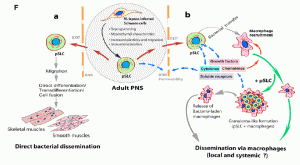ハンセン病
1月 17日の Cell誌に、ハンセン病について興味深い論文が掲載されました。
Reprogramming Adult Schwann Cells to Stem Cell-like Cells by Leprosy Bacilli Promotes Dissemination of Infection
Cell, Volume 152, Issue 1, 51-67, 17 January 2013
Copyright © 2013 Elsevier Inc. All rights reserved.
10.1016/j.cell.2012.12.014Referred to by: Mighty Bugs: Leprosy Bacteria Turn Schwa…
Authors
- Highlights
- Leprosy bacteria reprogram adult Schwann cells by altering host-gene expression
- Bacterially reprogrammed cells resemble progenitor/stem-like cells (pSLC) of mesenchymal trait
- pSLC promote bacterial spread to mesenchymal tissues by redifferentiation
- pSLC secrete immune factors, recruit macrophages, transfer bacteria, form granulomas, and disseminate infection
Summary
Differentiated cells possess a remarkable genomic plasticity that can be manipulated to reverse or change developmental commitments. Here, we show that the leprosy bacterium hijacks this property to reprogram adult Schwann cells, its preferred host niche, to a stage of progenitor/stem-like cells (pSLC) of mesenchymal trait by downregulating Schwann cell lineage/differentiation-associated genes and upregulating genes mostly of mesoderm development. Reprogramming accompanies epigenetic changes and renders infected cells highly plastic, migratory, and immunomodulatory. We provide evidence that acquisition of these properties by pSLC promotes bacterial spread by two distinct mechanisms: direct differentiation to mesenchymal tissues, including skeletal and smooth muscles, and formation of granuloma-like structures and subsequent release of bacteria-laden macrophages. These findings support a model of host cell reprogramming in which a bacterial pathogen uses the plasticity of its cellular niche for promoting dissemination of infection and provide an unexpected link between cellular reprogramming and host-pathogen interaction.
ハンセン病で、らい菌 (Mycobacterium leprae; ML) がどうやって広まるかを明らかにした論文です。筆頭著者は日本人のようです。反響の大きな論文で、Cell誌の Leading Edgeに “Mighty Bugs: Leprosy Bacteria Turn Schwann Cells into Stem Cells” として扱われていますし、Nature Newsでも “Leprosy bug turns adult cells into stem cells” として紹介されました。ハンセン病は神経内科医としても興味ある疾患ですので、論文を読んでみました。非常に専門的かつボリュームのある論文でしたので、ごく簡単に内容を記します。
らい菌は末梢神経を覆うシュワン細胞を侵しますが、著者らはらい菌が感染したシュワン細胞の核から Sox10が失われていることを発見しました。Sox10は成熟したシュワン細胞に発現しており、細胞のホメオスターシスやミエリンの維持などに関与している大事な因子です。感染したらい菌の量が少ない時は問題ありませんが、らい菌の量が多くなると、シュワン細胞の核から Sox10が除去され、Mpzを含む遺伝子群のダウンレギュレーションが起こります。このようなシュワン細胞では、細胞のリプログラミングが起こり、前駆/幹様細胞 (progenitor/stem-like cells; pSLC) としての性質を持ちます。FACSでの解析から、pSLCではミエリンのマーカーである p75や Sox10が消失している一方で、Sox2が維持されていることが明らかになりました。Sox2は山中の 4因子の一つで、分化多能性維持に働く転写因子です。同じマイコバクテリウムであっても、Mycobacterium smegmatisではこのようなリプログラミングは起こりません。
pSLCまでリプログラミングされた細胞は、中胚葉、特に筋肉に分化することが可能になります。実際に、らい菌に感染した pSLCは、骨格筋や平滑筋に移動し、そこで筋肉に分化し、感染を拡大します。
さらに、pSLCは筋肉から筋周膜の結合組織を経て骨格筋皮膚間に移動します。そこで、らい菌の感染は pSLCからマクロファージに広がります。また筋肉の炎症によっても、pSLCから炎症部位に集まったマクロファージにらい菌がうつります。一旦マクロファージが感染すると、感染していなかったマクロファージにも感染が広がって行きます。pSLCは骨格筋皮膚間でマクロファージとともに肉芽腫様構造物を作りますが、ここから感染したマクロファージが放出されることで、さらに感染が拡大します。
もっと簡略化して説明すると次のようになります。論文の Figure. 7Fの図がとてもわかりやすいです。
多くのらい菌がシュワン細胞に感染すると、シュワン細胞は前駆/幹様細胞までリプログラミングされます。前駆/幹様細胞は筋肉に移動して、らい菌を含んだまま筋肉に分化して感染を拡大します。また、前駆/幹細胞にいるらい菌がマクロファージに移ることでも感染は拡大します。前駆/幹細胞がマクロファージとともに形成する肉芽腫様構造物は、そこから感染したマクロファージを放出することで感染の拡大に貢献します。
感想ですが、同じマイコバクテリウム属の結核菌や非定型抗酸菌でこのようなリプログラミングが起きているのかどうかが、気になりました。
上に示した Nature newsの記事は、アルツハイマー病などでの再生医療につながる可能性についても、最後の一文のみではありますが、ちらりと触れています。

